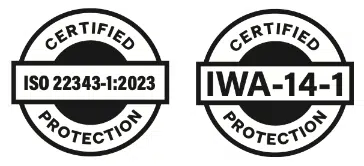With the market for bollards growing exponentially over the past decade and with more varieties than ever, it can often be helpful to simplify the decision-making process. The first step to finding the correct bollard is questioning what kind of service you want the bollards to provide for your city.
It is undeniable that bollards have become a paramount feature of our modern landscape. Used to manage pedestrian and vehicle traffic, light pedestrian pathways, enhance landscape and architecture, and secure and protect citizens from hostile vehicles, bollards are a significant cornerstone in city planning and landscape architecture. As such, bollards come in a wide range of designs and materials, and depending on the intended use, offer unique advantages and disadvantages. More specifically, when it comes to creating an effective security plan, choosing the right kind of bollard is essential. Yet, with the smorgasbord of options currently in the market, it can often be an intimidating task to decide which bollard is the right fit for you.
What is a Bollard?
On a rudimentary level, bollards are posts either used to limit access to certain areas, control the flow of traffic, or improve safety by stopping hostile vehicles. Typically, bollards are made of concrete or metal, available in varying sizes, and have rounded tops. Yet as vehicles become larger, heavier, and higher powered, the installation and design of bollards has adapted in response. Nowadays varieties range from flexible bollards that can easily be hit without damage, to security bollards designed to protect buildings and pedestrian zones by stopping the vehicles that hit them.
With the market for bollards growing exponentially over the past decade and with more varieties than ever, it can often be helpful to simplify the decision-making process. The first step to finding the correct bollard is questioning what kind of service you want the bollards to provide for your city. Asking questions that touch on the function, aesthetic appeal, cost, maintenance, and durability needed for your project are guaranteed to guide you in the right direction. Ideally, the bollard you choose should be in place for years to come, so it’s important to set off time to answer these questions when planning a project’s total cost. In short, this guide sets out to simplify the process by reviewing six bollards in terms of their durability, aesthetic appeal, cost, maintenance and protection level.
Flexible Bollards
Flexible plastic bollards (or impact recovery systems) are bollards that have an ability to flex up to 90 degrees when struck by a vehicle – they can bend without losing shape, ripping off, or cracking. As such, flexible plastic bollards are perfect for tight, high-traffic areas where vehicle collisions may occur – at first glance, they look like metal bollards and so drivers tend to avoid them. Additionally, if they are struck by a vehicle, they will incur little-to-no damage on the vehicle or to the bollard itself – lowering the replacement and maintenance schedule. Put simply, flexible bollards are durable, affordable, and effective at traffic management. However, when it comes to ensuring the security of an area or city, these flexible bollards offer very little protection and will not be able to stop a large vehicle travelling at a high speed and are thus not an appropriate HVM measure. Furthermore, because flexible plastic bollards prioritize visibility they are not designed with aesthetics in mind and tend not to blend into a city’s atmosphere.
Steel Pipe Bollards
Heavy-duty steel pipe bollards are usually constructed from structural grade steel and are then filled with concrete to prevent them from collapsing in the event of a hostile vehicle attack. The bollards are usually installed in parking lots, pedestrian areas, and around gas meters. They are affordable, cost-effective, and simple to install. Furthermore, if the bollards need to fit a city’s aesthetic, they can be upgraded with decorative architectural bollard sleeves to improve their appeal. When it comes to maintenance, paint can provide some prevention against corrosion, but requires yearly reapplication. If a bollard post is left untreated, varying temperatures and moisture can cause rust and weaken the bollard over time. In general, steel pipe bollards are a great choice for buyers who are looking for a simple, durable, somewhat affordable, and aesthetically pleasing bollard option that offers a significant amount of protection against a hostile vehicle attack.
Crash-Rated Bollards
Crash-rated bollards are one of the best options for a site that is particularly vulnerable to hostile vehicle attacks – they are the leader of anti-terrorist bollards and have been part of the urban landscape for centuries. The bollards are designed and test-rated to stop impacts from vehicles and prioritize stopping-power over anything else. Offering a high level of security against vehicle attacks, crash-rated bollards are a great fit for highly populated streets, markets, and historic site. The crash-rated bollard is not generally designed with aesthetics in mind and can often contribute to a hostile environment. Yet, the bollard is usually just the inner-core of an installation – it is primed or galvanized to protect against any moisture – and can be covered with a sleeve to fit into a cityscape and increase longevity. In short, although these bollards are on costlier side, they are often the go-to choice for urban designers and landscape architects who want to prioritise the safety of citizens.
Bolt Down Bollards
Bollards typically come in two types, dig-in and bolt-down. A dig-in bollard is able to handle a higher level of impact, as it is dug into the ground. However, a bolt-down bollard (or a surface mounted bollard) is still an excellent way to protect certain areas, but easier to install as they can be bolted into existing concrete surfaces either outdoors or indoors. Put simply, they can be installed relatively quickly and used effectively to protect expensive equipment or pedestrians from the impact of a vehicle. Furthermore, surface mounting a bollard can be an affordable way to keep your bollard costs low and depending on the bollard you choose, maintenance can be kept at a minimum and the design can fit well into a cityscape. That being said, when compared to dig-in bollard, bolt-down bollards offer significantly less protection. This could be a dealbreaker if protection is a priority.
Concrete Bollards
Concrete bollards are a sophisticated and protective option for your HVM measure. Not only are they virtually maintenance free and come at a low cost, the concrete bollards are often reinforced with epoxy-coated steel rebar and offer high impact protection for a cityscape. Because of this, they are generally ideal for mixed-use environments such as sidewalk crossings, building entrances, parking lots, and high-traffic areas. In addition, they tend to work well with modern architecture aesthetics and, as such, offer a unique combination of design and protection – they are available in varying heights and styles to complement a range of architectural and landscape styles. That being said, public opinion on the concrete barricades is divided. For example, NSW Police Minister Troy Grant recently accused Sydney’s Lord Mayor, Clover Moore, of “causing unnecessary panic and confusion” after claiming that the state government was not consulted prior to the installation of the barricades in Martin Place.
Retractable (Electric) Bollards
Retractable bollards offer high flexibility when it comes to adding security to multi-use spaces – they can restrict access to areas as needed, allow temporary access, or temporarily manage traffic flow. This is a great solution for cities that want to control access to sensitive sites and protect strategic access points from terror attacks. Retractable bollards usually provide a high level of protection – for example, the highest rated bollard on the CPNI website has a performance rating of V/7500[N3]/80/90:4.3/24.0. However, the cost of retractable bollards can be significantly high – this is due to the cost of the bollard, installation, and maintenance costs. Furthermore, these bollards are susceptible to environmental conditions, especially oxidation and rusting in high-saline environments as well as de-icing chemicals. Although retractable bollards are usually coated to prevent corrosion and wear, routine maintenance needs to be done every 3 months.






